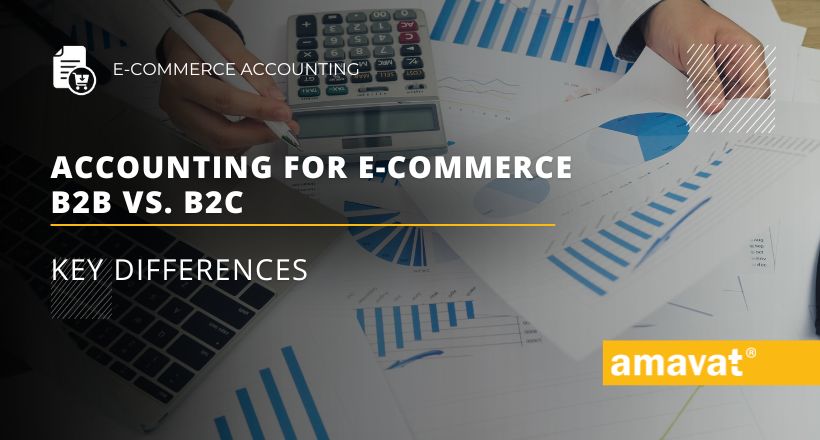Accounting for e-commerce: B2B vs. B2C – Key differences
E-commerce as a rapidly evolving sector, attracts businesses with various models. Two of the most prominent are B2B (business-to-business) and B2C (business-to-consumer), which differ not only in sales strategies but also in accounting and financial management. In this article, we will explore the key differences between these models in the context of e-commerce, focusing on accounting and financial aspects crucial for effective business management.
Purchase process
In the B2B model, the purchasing process is significantly more complex than in B2C. Companies operating in the B2B sector often engage in long-term negotiations that may involve multiple decision-makers and complex offer evaluations. The B2B purchasing process typically includes several steps, such as budget approval, supplier evaluation, and contract negotiations. This approach allows businesses to better tailor products or services to their needs and often leads to long-term relationships with suppliers.
In contrast, the B2C purchasing process is more straightforward. Customers make purchases individually, driven by personal preferences, emotions, and immediate needs. Decisions are usually made quickly, and purchases can be impulsive. This process is simpler and shorter, meaning businesses must efficiently handle a large number of transactions in a short time.
Pricing and fees
In the B2B model, prices are often negotiated and can be tailored to the specific needs of the client. B2B companies may offer discounts for larger orders, long-term contracts, or other benefits that affect the final price of a product or service. This pricing model requires flexibility and precise contract and invoice management, often involving more documentation and complex accounting procedures.
In the B2C model, prices are typically set in advance and are less flexible. B2C companies may use promotions, discounts, or loyalty programs to attract customers, but these actions are planned ahead and do not require as complex negotiations as in B2B. B2C customers do not have the ability to negotiate prices, and any discounts are part of the company’s marketing strategy.
Payment methods
In the B2B model, payments are often more spread out over time. Companies may establish long payment terms, such as 30, 60, or 90 days, and use various payment methods, such as deposits or installment payments. This system requires careful cash flow management, as businesses must cope with long payment cycles and potential delays.
In the B2C model, payments are usually made immediately, using credit cards, cash on delivery, or other quick payment methods. In this case, accounting focuses on fast payment processing and cash flow management. This approach simplifies financial management but requires effective monitoring of a large number of transactions.
Impact on accounting
- Average transaction value: In the B2B model, the average transaction value is significantly higher than in B2C, leading to larger invoice amounts and longer repayment periods. B2B businesses may have fewer transactions, but of greater value. For accounting, this means a need for precise monitoring and management of large sums and long payment cycles.
- Turnover and profit margins: B2B businesses may have lower turnover but higher profit margins, as they operate with larger transactions and long-term contracts. In contrast, B2C companies typically have higher turnover but lower profit margins due to lower prices and higher marketing costs. Accounting in B2C must handle a larger number of transactions but of lower value, requiring efficient cost and revenue management.
- Accounts management: Accounts receivable in B2B can be more extensive and require detailed credit risk analysis, which can affect the company’s cash flow. B2B accounting must effectively manage long repayment periods and monitor credit risk. In B2C, accounts receivable is shorter and less complicated but managing a large number of transactions requires an efficient system for monitoring and processing payments.
- Pricing strategy: B2B often uses individual pricing strategies and negotiations, which require more complex accounting management. In B2C, prices are usually predetermined and applied to all customers, simplifying the accounting process but requiring effective management of promotions and discounts.
If you need support with managing your e-commerce business, amavat® is the perfect solution. We offer comprehensive accounting services for e-commerce clients in Poland, alongside VAT Compliance solutions for the e-commerce sector throughout Europe. In addition, we provide an innovative application that seamlessly integrates accounting with IT solutions, enabling the optimization of financial processes and boosting operational efficiency: Schedule a free consultation today.
Summary
The differences between B2B and B2C models in e-commerce significantly impact accounting and financial management. The B2B model requires a more complex approach to transaction, payment, and accounts management, while the B2C model focuses on high transaction volumes and simpler accounting procedures. Understanding these differences is crucial for effective financial management and adjusting accounting strategies to the specifics of the chosen business model.
When planning financial and accounting strategies, businesses should consider the specifics of their business model. For B2B companies, managing long-term contracts and large sums is crucial, while B2C firms need to effectively handle a high volume of transactions and operational costs. Ultimately, understanding the key differences between B2B and B2C will enable better adaptation of accounting and financial practices to the requirements of a given e-commerce model.





